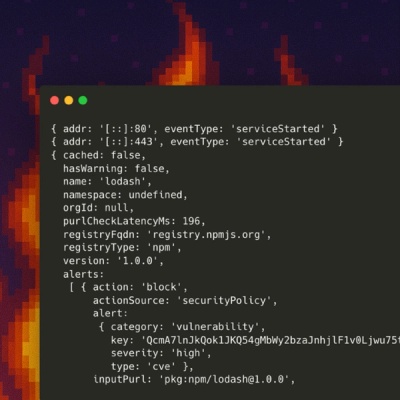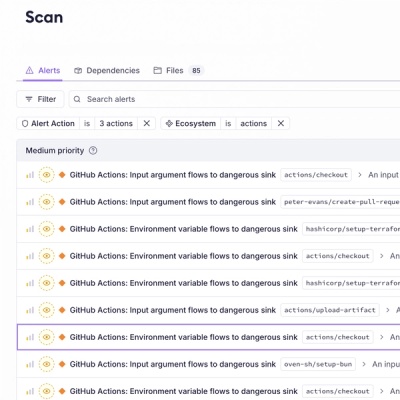
Product
Introducing Socket Firewall Enterprise: Flexible, Configurable Protection for Modern Package Ecosystems
Socket Firewall Enterprise is now available with flexible deployment, configurable policies, and expanded language support.
@formcentric/client
Advanced tools
Formcentric Client package for rendering Formcentric Headless Forms.
npm install @formcentric/client
To implement a form on your Page, two things are needed:
div with the data-attribute fc-id@formcentric/client ScriptThe Client-Script needs to load the formapp.js, because of this the said file has to be served and reachable.
The Theme consists of:
styles.css containing all styles with custom propertiesscript.js defining the templates for the input fields_variables.json defined on the body or the embed-div itselfThe client does not contain any theme information, and will only work if you are providing these requirements.
To create a custom theme, follow these steps in your app's root directory. This command generates a new theme, based on our default Formcentric theme, in the fc-themes folder. Optionally, you can base your custom theme on any of the other provided Formcentric themes by specifing its directory name in the second argument.
// npm
npm run fc-create-theme [fcThemeName]
// yarn
yarn fc-create-theme [fcThemeName]
// pnpm
pnpm fc-create-theme [fcThemeName]
To use your custom theme, bundle its templateEntry file to a single file script.js in your custom theme's root directory and specify the path on your formDiv (see example below).
If you want to customize field widths you can do so in _field.scss or any other css file included in your website. Please keep in mind that row calculations depend on these values, so if you decide to change them you should make sure that CORS is configured correctly. Formcentric client should be able to read the relevant css file programatically to extract your customized field widths.
<div
data-fc-id="..."
data-fc-data-url="https://formcentric.com/headless-server"
data-fc-formapp-url="assets/formapp.js"
data-fc-theme-dir="fc-themes"
data-fc-theme="formcentric"
></div>
formapp.jsscript.jsstyles.css_variables.jsonMost of the configuration is done via the data-attributes on the embed-div,
but some scenarios may call for mor advanced control over the rendering app.
This is done via the window.formcentric Object. It follows the following interface.
Most of the options are readonly and should not be touched.
declare interface Window {
formcentric?: {
initFormcentric?: (debugMode: boolean) => void
formapp?: {
templates?: fcTemplates
start?: Start
instances?: {
[embedId: string]: {
reSetFormDefinition?: (reSetFormDef: fcClientFormDefinition) => void
initElement?: HTMLElement
options?: {
baseUrl: string
embedId: string
instanceId: string
persist: boolean
formDefinition?: fcClientFormDefinition
contentHandler?: string
debug?: boolean
locale?: string
}
stop?: VoidFunction
unmount?: VoidFunction
initialRequestHeaders?: Record<string, string>
}
}
}
}
}
Especially useful are the initialRequestHeaders. They are passed to the initial Request for getting the formDefinition.
<script>
window.formcentric ??= {}
window.formcentric.formapp ??= {}
window.formcentric.formapp.instances ??= {}
window.formcentric.formapp.instances['b1265a82-0eab-47ac-hhhh-948b18e423c5'] = {
initialRequestHeaders: { testHeader: '123' },
}
</script>
<script
src="./formcentric.js"
defer
></script>
Everytime formcentric.js gets executed, every Form-Container (identified by data-fc-id) gets initialized as a form.
You can manually call window.formcentric.initFormcentric() to setup and start the client for all divs with and fc-id data-attribute.
No configuration is needed if the embedded form is present during initial page loads. However, if the form is embedded in a single page application and only rendered when certain states are set. The following configuration is necessary to enable double optin.
Configure data-fc-parent-url attribute on the form div. This attribute can be used to parameterize the internal state of embedding single page applications. For example if the client is running in a modal open modal state when users click on the opt in link can be restored by storing the neccessary information as parameters in the parent url attribute. The embedding app should then be configured in a way that it restores the states necessary to render the form.
const FormModal = () => {
const [open, setOpen] = useState(false)
useEffect(() => {
const urlParams = new URLSearchParams(window.location.search)
const formOpen = urlParams.get('formopen')
if (formOpen) {
setOpen(true)
}
}, [])
return (
<div
data-fc-id='...'
data-fc-parent-url='https://admiralcorp.com/?formopen=true'
/>
)
}
FAQs
Formcentric-Client package for rendering Formcentric-Headless Forms
The npm package @formcentric/client receives a total of 667 weekly downloads. As such, @formcentric/client popularity was classified as not popular.
We found that @formcentric/client demonstrated a healthy version release cadence and project activity because the last version was released less than a year ago. It has 3 open source maintainers collaborating on the project.
Did you know?

Socket for GitHub automatically highlights issues in each pull request and monitors the health of all your open source dependencies. Discover the contents of your packages and block harmful activity before you install or update your dependencies.

Product
Socket Firewall Enterprise is now available with flexible deployment, configurable policies, and expanded language support.

Security News
Open source dashboard CNAPulse tracks CVE Numbering Authorities’ publishing activity, highlighting trends and transparency across the CVE ecosystem.

Product
Detect malware, unsafe data flows, and license issues in GitHub Actions with Socket’s new workflow scanning support.